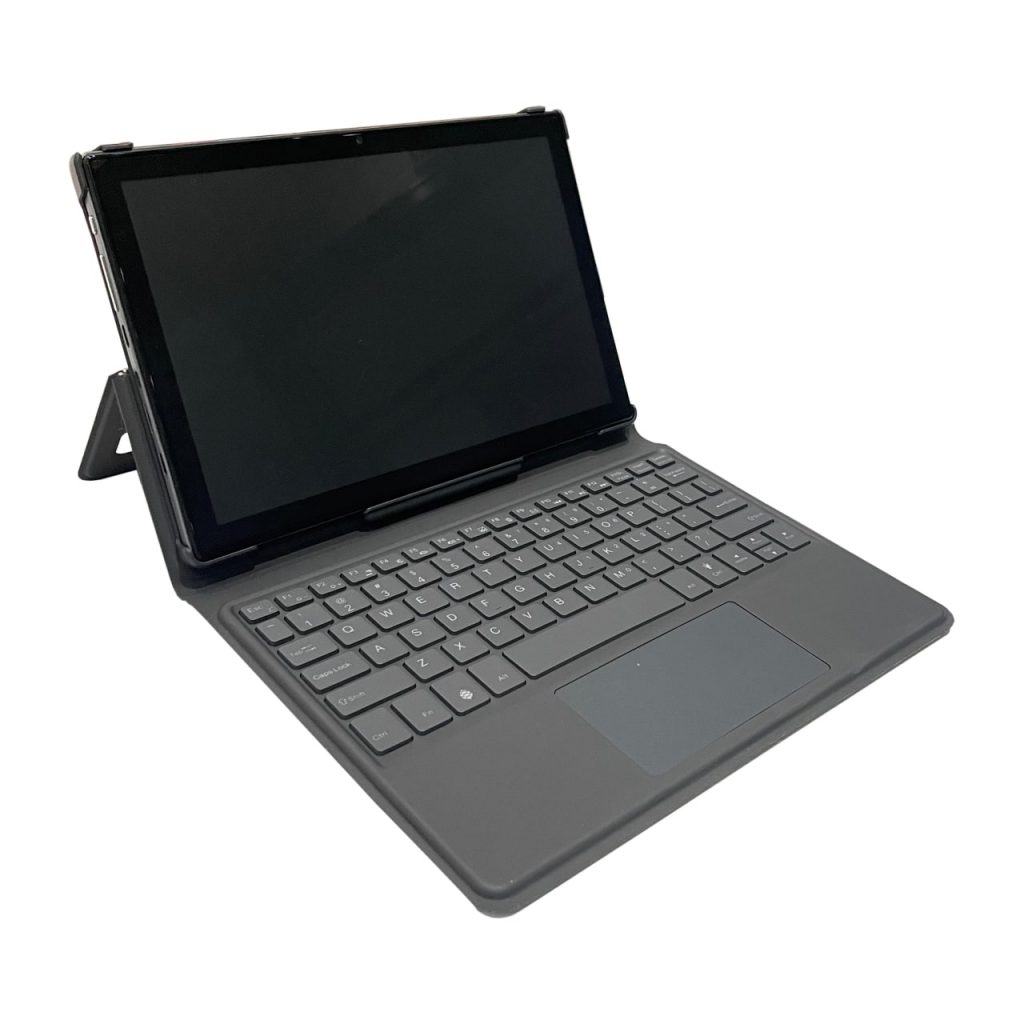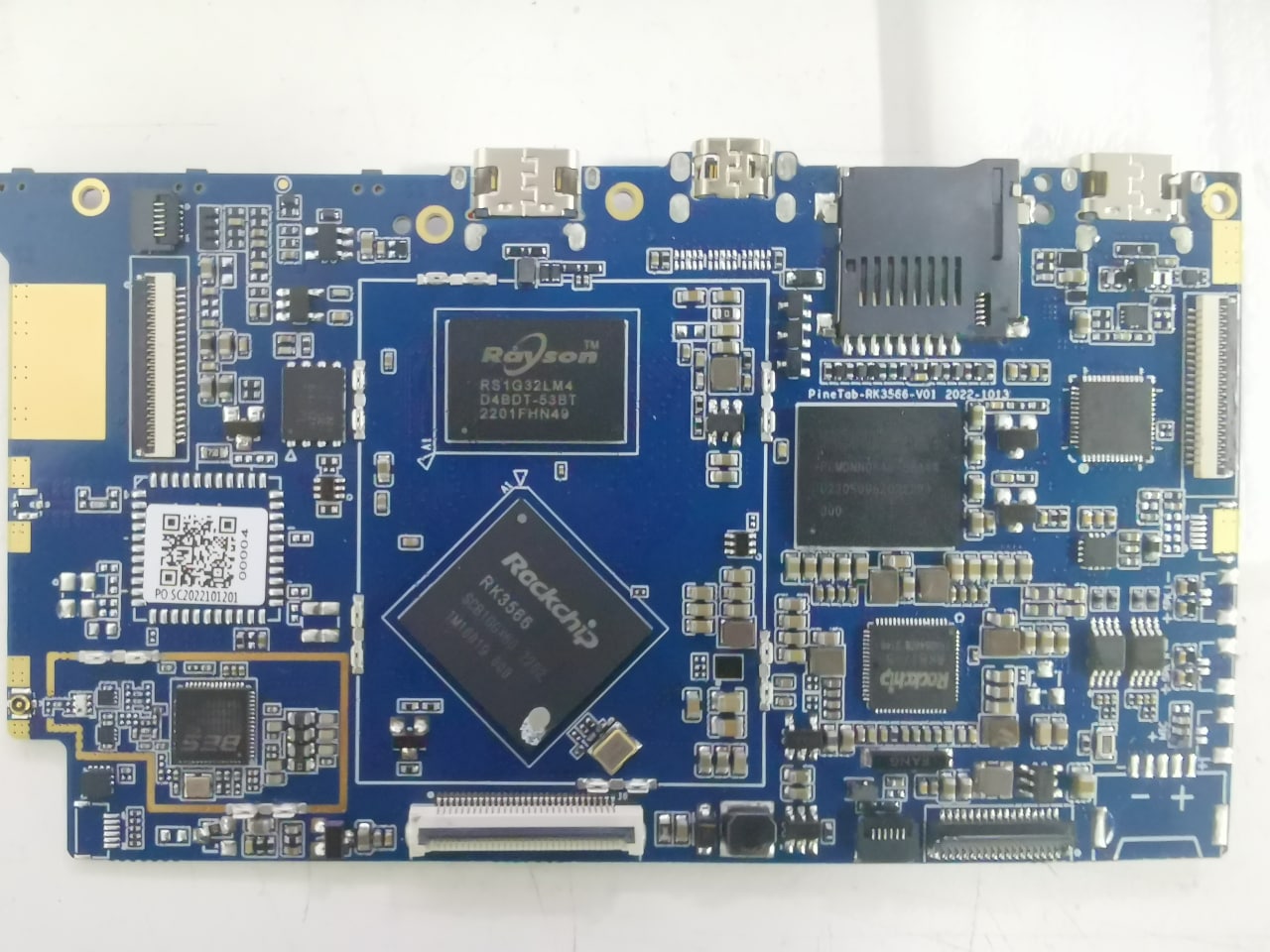PineTab2
The PineTab2 is PINE64's successor to the original PineTab Linux tablet computer, featuring a faster processor and better availability. The tablet is available in two configurations, 4GB of RAM and 64GB of internal storage or 8GB of RAM and 128GB of internal storage. The tablet ships with a detachable keyboard that doubles as a protective cover.
The tablet is designed around the Rockchip RK3566 processor, which features 4 energy-efficient Cortex-A55 64-bit ARM cores and enjoys good mainline Linux support. Similarly packaged RISC-V tablet is PineTab-V.
Pre-orders started on the 13th of April 2023, with pricing starting at USD 159 for the 4GB/64GB version and USD 209 for the 8GB/128GB version. The PineTab2 began shipping on June 2, 2023, with deliveries expected to reach purchasers the week of June 5th.
Specifications
- SoC: Rockchip RK3566
- CPU: 4x ARM Cortex-A55 @ 1.8 GHz
- 32KB L1 Instruction Cache and 32KB L1 Data Cache per core
- 512KB unified system L3 cache
- ARMv8 Cryptography Extensions
- GPU: Mali-G52 MP2 @ 800 MHz
- Supported by the open source 'Panfrost' driver in Linux and Mesa
- Supports OpenGL 3.1 and OpenGL ES 3.1 with many newer extensions
- NPU: 0.8 TOPS Neural Processing Unit
- RAM: 4GB or 8GB LPDDR4
- Storage:
- 64GB or 128GB internal eMMC
- 1x MicroSD slot
- Display: 10.1" IPS LCD Resolution 1280x800
- Cameras:
- Front: 2Mpx, chipset: Galaxycore GC02M2
- Rear: 5Mpx, chipset: Omnivision OV5648
- Battery: 6000 mAh (22.2Wh)
- Buttons: Power, volume up, volume down
- Network:
- Wi-Fi
- Bluetooth
- I/O:
- 1x USB-C 3.0
- 1x USB-C 2.0
- 1x MicroHDMI
- 1x 3.5mm audio jack
- 1x 5 pin Pogo connector for keyboard
- (PCIe on PCB as a flat flex ribbon connector, no room for M.2 NVMe drives in case)
- Multimedia:
- rkdjpeg: 1080p120 JPEG decode
- no driver in mainline yet
- hantro: JPEG/VP8/H.264 encode, 1080p MPEG-2/H.263/VP8/H.264 AVC decode
- mainline driver does not yet support all codecs/functions
- see Mainline Hardware Decoding and Mainline Hardware Encoding
- rkvdec2: 4K H.264 AVC Main10 L5.1/H.265 HEVC Main10 L5.1/VP9 Profile 0 and 2 L5.1 decode
- no driver in mainline yet
- rkvenc2: 4K H.264 AVC/H.265 HEVC encode
- no driver in mainline yet
- rkdjpeg: 1080p120 JPEG decode
- Build: Metal and Plastic
- Dimensions: 242x161x9mm
- Misc:
- Protective cover with keyboard
Development efforts
Main Article: Quartz64 Development
Linux mainline is already quite far along for the device, as the SoC is the same as is used in the Quartz64 line of devices. Check the main article for the big picture; PineTab2 specific issues are listed here.
Known Issues
- The display panel driver is in PineTab2's kernel fork, and needs to be submitted to upstream.
- The BES2600 Wi-Fi driver needs porting/major cleanup. This is a priority, but for now, you can USB tether a phone or use a supported WI-FI dongle.
- The BES2600 Bluetooth driver needs to be implemented.
- The Camera driver needs to be written.
- Suspend does not currently work due to a driver issue. Suspend is disabled in the factory image for your protection. Caveat Emptor if you chose to unmask the feature prior to it being fixed.
Board information, schematics and certifications
PineTab2 mainboard schematic:
PineTab2 certifications:
- Available soon
Datasheets for Components and Peripherals
Rockchip RK3566 SoC information:
Frequently Asked Questions
Does the Tablet support a Pen?
No, adding a digitiser for pen inputs would make the price too high.
Can I run Android on it?
Theoretically yes, practically there's little chance anyone wants to make a well-supported Android build for this device. If you're looking for an Android tablet, buy any mainstream tablet, you'll get better value for your money.
Is there SPI Flash?
Unclear. The schematic shows a 128Mbit SPI flash chip, but it's possible that production models won't have it populated. Update this section once we've determined this.
My only Development Experience is Visual Basic Macros in Excel and Redstone in Minecraft, should I buy this?
At this stage, probably not, unless you're happy with a tablet that has a buggy Wi-Fi driver and no camera controller driver.
How does the Tablet compare to a Pinebook Pro?
It's slower, as it is intended to be a successor to the PineTab1, not the Pinebook Pro. It'll still handle web browsing, video playback and documents fine though.
What is the Performance of the PineTab2 compared to the PineTab-V?
The PineTab2 is notably faster than the PineTab-V. You can see this by comparing the Quartz64 sbc-bench results to the Star64 ones. Performance should not be a factor of consideration when purchasing a PineTab-V.
Does PineTab2 play back DRM'd Content such as Netflix?
No, there are no Widevine binaries included in the image the PineTab2 ships with. They need to be taken from ChromeOS and probably patched https://gist.github.com/DavidBuchanan314/c6b97add51b97e4c3ee95dc890f9e3c8
How-to
Putting the Device into Maskrom Mode
To recover from a bad eMMC/SPI flash, it seems you can make the bootrom enter the USB recovery mode by applying a low(?) signal to the SSTX1_P or SSTX2_P pin of the USB2-only Type-C connector (the one that does UART.)
Networking using USB
Until the internal BES2600 WIFI has a stable driver, the community suggests that you connect using USB. This section summarizes the more detailed information in File:PineTab2 USB Guide.pdf, which covers connecting via a tethered Android phone, a suitable USB WIFI adapter, a wired USB Ethernet adapter, and a tethered iOS device.
Selecting a USB WIFI Adapter
Insert a supported WIFI dongle in the upper USB port, using a USB-C to USB-A adapter as necessary. As a general rule, single state adapters are recommended. Even better, select one from this list: https://github.com/morrownr/USB-WiFi/blob/main/home/The_Short_List.md
If you must use a multi-state adapter and it isn't recognized by the kernel, you can try ejecting the device. This should force it back into adapter mode. If this does not work, you can try installing usb_modeswitch to troubleshoot. You will need to temporarily use another method to get internet (such as phone tethering below) or load the package on an SD card to install it.
Performing USB Tethering with an Android Phone
This guide simply describes HOW to undertake this option. The user is responsible for ensuring that their wireless plan permits such use, and for any fees incurred.
You can use an Android phone as a network adapter.
You'll need:
- An Android phone
- A USB OTG adapter (USB-C to USB-C may work, not tested)
- Some knowledge of your variation of Android
Do the following in order:
- Plug in the device to the PineTab2 using the USB cable and a USB OTG adapter
- On your android phone, open the settings app (specifics from here may vary on version)
- Navigate to "Network & Internet"
- Navigate to "Hotspot & Tethering"
- Tap on "USB Tethering"
You should now see a new network interface on the PineTab2.

